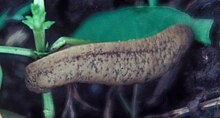Sarasinula plebeia
| Sarasinula plebeia | |
|---|---|

| |
| A live individual of Sarasinula plebeia | |
| Scientific classification | |
| Kingdom: | |
| Phylum: | |
| Class: | |
| (unranked): |
|
| Superfamily: | |
| Family: | |
| Genus: | |
| Species: | S. plebeia
|
| Binomial name | |
| Sarasinula plebeia (P. Fischer, 1868)[1]
| |
| Synonyms[2][3] | |
| |
Sarasinula plebeia, commonly called the bean slug or the Caribbean leatherleaf slug, is a species of air-breathing land slug, a terrestrial pulmonate gastropod mollusk in the family Veronicellidae, the leatherleaf slugs.
As of November 2012[update], some websites and databases (including the ITIS entry) have a species listed as "Sarasomia plebeia" by the same author.
Distribution[edit]
Sarasinula plebeia was originally discovered and described under name Vaginulus plebeius by French zoologist Paul Henri Fischer from New Caledonia in 1868.[1] The type locality is New Caledonia.[1]
The distribution of Sarasinula plebeia includes:
- Cuba[4]
- Jamaica[5]
- Saint Martin, Leeward Islands[6]
- Dominica[5]
- Canouan[5]
- Saba Island[6]
- "Southern USA"[5]
- from Mexico[2] to Panama:[5]
- Rio Grande do Sul,[9] Brazil
- Venezuela[10]
It was also introduced to Australasia and some Pacific island groups:[5]
- Saipan,[6] Mariana Islands
- Ritidian Point,[6] Guam
- San José, Leyte, Philippines[6]
- Wasi, Ambon Island, Moluccas[6]
- Vate, Aoba Island, Malakula Island, Espiritu Santo and Malo Island, New Hebrides[11]
The species is already established in the USA, and is considered to represent a potentially serious threat as a pest, an invasive species which could negatively affect agriculture, natural ecosystems, human health or commerce. Therefore it has been suggested that this species be given top national quarantine significance in the USA.[12]
Ecology[edit]
Parasites of Sarasinula plebeia include:
As a pest[edit]
In Central America, Sarasinula plebeia is a serious pest of agriculture.[5]
Genetics[edit]
The species is economically important, but as of 2001, only partial sequences of the 28S ribosomal RNA gene of the species had been published by Dayrat et al.[14] up to April 2010.
References[edit]
This article incorporates CC-BY-3.0 text from the reference.[5]
- ^ a b c Fischer, P. (1868). Crosse, H.; Fischer, P. (eds.). "Diagnoses de deux Limaciens de la Nouvelle Calédonie". Journal de Conchyliologie (in French). 16. Paris: 145–146. ISSN 0021-7719. Retrieved 23 November 2012.
- ^ a b Naranjo-Garcia E., Thome J. W. & Castillejo J. (2007). "A review of the Veronicellidae from Mexico. (Gastropoda: Soleolifera). Revision de los Veronicellidae de Mexico (Gastropoda: Soleolifera)". Revista Mexicana de Biodiversidad. 78: 41–50. doi:10.22201/ib.20078706e.2007.001.418.
- ^ Terrestrial Mollusc Tool: Sarasinula
- ^ Maceira D. F. (2003). "Las especies de la familia Veronicellidae (Mollusca, Soleolifera) en Cuba". Revista de Biología Tropical 51(3): 453-461. PDF Archived 2007-07-28 at the Wayback Machine.
- ^ a b c d e f g h Robinson D. G., Hovestadt A., Fields A. & Breure A. S. H. (July 2009). "The land Mollusca of Dominica (Lesser Antilles), with notes on some enigmatic or rare species". Zoologische Mededelingen 83 http://www.zoologischemededelingen.nl/83/nr03/a13
- ^ a b c d e f Forcart L. (1973). "Notes on Veronicellidae and Athoracophoridae in Field Museum of Natural History, Chicago". The Nautilus 87(1): 25-27.
- ^ Naranjo-García E., Thomé J. W. & Castillejo J. (2007). "A review of the Veronicellidae from Mexico (Gastropoda: Soleolifera). Revisión de los Veronicellidae de México (Gastropoda: Soleolifera)". Revista Mexicana de Biodiversidad 78: 41-50."
- ^ (in Spanish) Barrientos Z. (2003). "Lista de especies de moluscos terrestres (Archaeogastropoda, Mesogastropoda, Archaeopulmonata, Stylommatophora, Soleolifera) informadas para Costa Rica". Rev. Biol. Trop. 51(Suppl. 3): 293-304. PDF Archived 2011-06-29 at the Wayback Machine
- ^ Agudo-Padrón A. I. (14 May 2009). "Recent Terrestrial and Freshwater Molluscs of Rio Grande do Sul State, RS, Southern Brazil Region: A Comprehensive Synthesis and Check List". Visaya April 2009: 1-13. PDF Archived 2012-11-05 at the Wayback Machine.
- ^ Fernández de V, J. 1992: Contribución al conocimiento de las babosas y sietecueros (Mollusca: Gastropoda) Revista de la Facultad de Agronomía Maracay. 12(3-4):374-387.
- ^ Forcart L. (1969). "Veronicellid land slugs from the New Hebrides from the New hebrides, with description of Semperula solemi, new species". Fieldiana 51(12): 147-156.
- ^ Cowie R. H., Dillon R. T., Robinson D. G. & Smith J. W. (2009). "Alien non-marine snails and slugs of priority quarantine importance in the United States: A preliminary risk assessment". American Malacological Bulletin 27: 113-132. PDF Archived 2016-06-16 at the Wayback Machine.
- ^ "Christoph Högger - Antagonists of Slugs and Snails". homepage.sunrise.ch. Archived from the original on 14 December 2007. Retrieved 12 January 2022.
- ^ Dayrat, B.; Tillier, A.; Lecointre, G.; Tillier, S. (2001). "New Clades of Euthyneuran Gastropods (Mollusca) from 28S rRNA Sequences". Molecular Phylogenetics and Evolution. 19 (2): 225–235. doi:10.1006/mpev.2001.0926. PMID 11341805.
Further reading[edit]
- Thomé J. W. (1975). "Os gêneros da familia Veronicellidae nas Américas (Mollusca; Gastropoda)". Iheringia Zoologia 48: 3-56.
- Rueda, A. A.; Slansky, F.; Wheeler, G. S. (1991). "Compensatory feeding response of the slug Sarasinula plebeia to dietary dilution". Oecologia. 88 (2): 181–188. Bibcode:1991Oecol..88..181R. doi:10.1007/BF00320809. PMID 28312130. S2CID 20970029.
- Rueda A., Caballero R., Kaminsky R. & Andrews K. L. (2002) "Vaginulidae in Central America, with emphasis on the bean slug Sarasinula plebeia (Fischer)". In: Barker G. M. (ed.). Molluscs as crop pests. CABI Publishing.
External links[edit]
- Sarasinula plebeia at National Center for Biotechnology Information (NCBI)
- Sarasinula plebeia on the UF / IFAS Featured Creatures Web site
